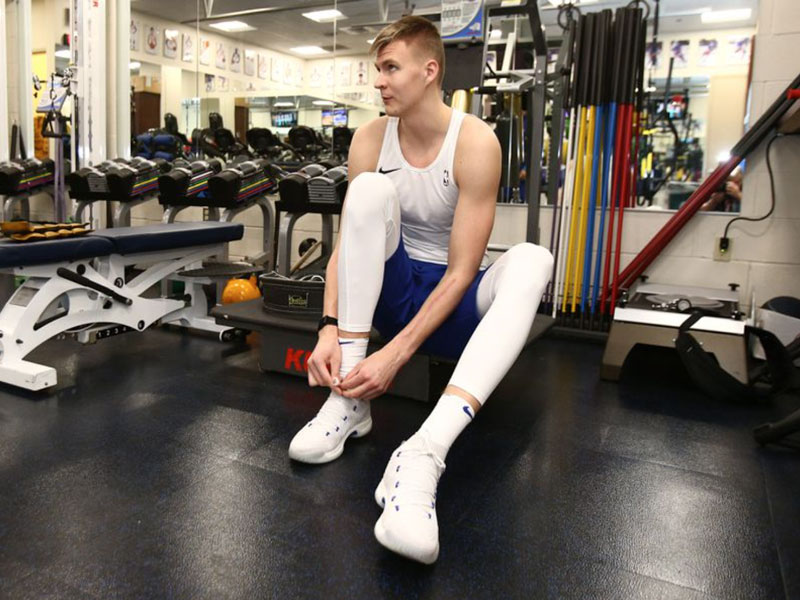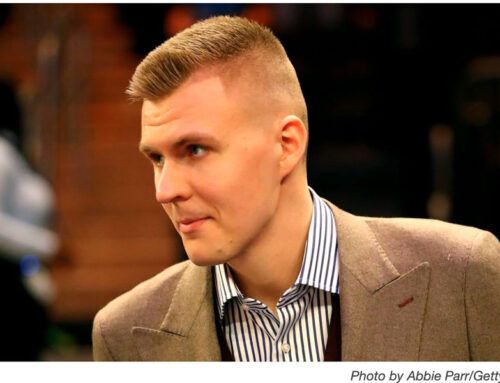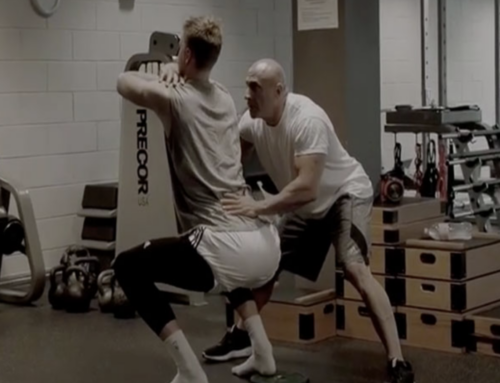AS Seen In The New York Daily news December 20, 2017
By nature and profession, Dr. Carlon Colker is a man of movement and some mystery. At times, words aren’t enough to explain his methods.
“Push me,” he says after dropping into a football stance.
Colker stumbles back. It was the third time he asked to be shoved during the interview. He re-positions and plants himself to the floor.
“Now push me again.”
It was like trying to move a rooted tree stump. Or Dwight Howard out of the post.
“You have to feel the ground as an extension, as a force,” Colker explains.
Colker, 52, is a ball of muscle. His muscles look like they have muscles that can bench press 700 pounds. He also has lots of ideas about maintaining his client, Kristaps Porzingis, and has put many of them already into action as the power forward’s personal physician and trainer.
“At this point, he just knows my body really well,” Porzingis says. “He knows what I need all the time — when I’m tired, when I’m not, whenever.”
Notably, Colker has no association with the Knicks. His work with Porzingis — conducted from Greenwich, Conn., to Liepaja, Latvia — is completely separate from that of the team’s employed doctors and trainers. But like others both affiliated with the team and working independently inside the Porzingis camp, Colker has become a key figure in an area most paramount to the franchise’s future: keeping a 7-3 ‘Unicorn’ strong and healthy.
There is no blueprint for such a unique task, but Colker, in a sitdown with the Daily News last month, peeled back the curtain on the methods – some of which he proudly acknowledges are controversial in his field – of Porzingis’ physical makeover last summer designed to promote lasting health and base power.
It was an unknown methodology, even to the Knicks.
“When KP first came to me, it was about a lot of injuries because of a disconnection. He stayed away from the basket, he shied away from the inside. For good reason. Because if he went inside to diversify his game, he would get banged up and hard,” says Colker, who works at two local hospitals and from his personal office in Greenwich, dubbed ‘Peak Fitness.’ “Because KP’s body wasn’t ready. The physical language wasn’t there. The wires weren’t connected yet.”
Between the squatting and the balance exercises, there’s no question Colker’s work with Porzingis was a boost to the Latvian’s game. While Porzingis was largely ineffective in the post during his previous two seasons, the 22-year-old has now developed inside efficiency and confidence predicated on powering through contact.
The health question is a lot trickier.
Monday’s loss to the Hornets represented Porzingis’ sixth missed game due to injury, which puts him on pace to play about 66 games this season – the same as last. But that stat is a bit misleading.
After two years of fading in the second half of the season while coping with injuries, Porzingis has bought into the idea that sometimes rest is better than risk.
“You’re playing through pain a lot of times and you keep going and because this is hurting, the next thing starts to hurt,” Porzingis says after missing his first game of the season – on Nov. 8 at Orlando — because of elbow and ankle issues. “Sometimes it’s smart when something’s hurting to maybe sit out one game and not later lose four games.”
Rest is the buzzword. It’s all about recovery. At the recommendation of his personal physiotherapist, Manolo Valdivieso, Porzingis underwent a hardcore physical exam in Spain over the summer to determine the best way to maximize results for his body type.
“I was like a rabbit (doing the tests),” Porzingis says. “I was doing all kinds of stuff. Running all day. They were killing me, putting things on (my chest), taking blood.”
The doctors determined Porzingis should cease “overtraining” because he was drained and losing too much weight. This falls in line with the philosophies of Colker, who recommends a full day off following each game. Porzingis also said Knicks doctors have advised him against playing even when he felt ready to return, like Saturday against the Thunder as he dealt with a sore knee.
The ‘Unicorn’ is being handled with care.

“You can’t pour out 30, 40 points per game and then back and practice the next day,” Colker says. “No, do nothing. Do nothing. Go play video games. Go eat. Go sleep. I’ll beat the s–t out of them. But then I want nothing.”
The partnership between muscle-bound doctor and the Knicks’ franchise player began with an injury. Toward the end of his rookie campaign in 2016, Porzingis was laboring through, among other ailments, a painful shoulder that forced him out of the final seven games.
Porzingis’ older brother and agent, Janis, contacted Colker in hopes of finding answers that weren’t arriving elsewhere.
“That’s where I gained so much trust in him,” Kristaps says. “Nothing was working. The whole summer I was working out, I was doing my treatment, and it wasn’t helping.
“So he was the one that really fixed my shoulder.”
Colker, a former bodybuilder and MMA fighter, turned that trust into a long-term plan for sculpting and maintaining Porzingis. The focus was on building up Porzingis’ base, so that he, too, felt the ground as an extension of himself. Colker says his strategy of using squats to build up strength in big men – which he also utilized with Shaquille O’Neal – is considered taboo in the industry.
“My perspectives are unusual,” he says. “My methods are novel and my techniques are unique. That doesn’t come without a price.
“When one lone beast raises his head to take stock of a situation, turns and goes a different direction, it draws the ire of the herd.”
More complicated, though, is Colker’s involvement in an ephedra scandal that followed the death of Orioles pitcher Steve Bechler in 2003. As a physician practicing internal medicine, Colker advocated the use of ephedra – a weight-loss and energy-boosting supplement – while claiming it was safe and effective. He was named as a defendant in three separate lawsuits, accused of falsifying data about the dangerous side effects of the supplement.
Colker denied the allegations. His attorney, Jonathan Whitcomb, says all three lawsuits against Colker were voluntarily dismissed.

“In my mind, he was vindicated,” Whitcomb says, though a judge in one of the lawsuits at the time thought his testimony lacked credibility.
In the 14 years since the ephedra scandal, Colker has built a client list that reads like an ESPY’s-Oscars fusion rehearsal — O’Neal, Andre Agassi, Quinton ‘Rampage’ Jackson, Jeremy Piven, Bradley Cooper. Just last year, in an interview with GQ, Justin Biebercredited Colker with convincing him to quit Adderall. When Phil Jackson was discussing deals for Porzingis, Shaq declared the Latvian untradeable because, in part, of his work with Colker.
“You keep Porzingis, and trade everybody else around him, and try to build around him. This kid has a bright future. He’s working out all summer,” the Hall of Fame center told TMZ. “I know the guy he’s working out with, Carlon Colker, a guy I used to work out with. A guy that helped me win championships. So, he’s getting stronger. He’s definitely in the weight room. He’s not the type of guy that you give up.”
In April, Porzingis skipped his exit meeting with Jackson and isolated himself from the Knicks. Less than a month later, Colker set the power forward on a structured plan consisting of a fat-heavy diet, exercise and rest. To demonstrate the focus of his efforts, Colker shares a video of Porzingis exploding to a squat from a double-kneeling position with a weight strapped to his waist – “This is what I mean by building the quad strength and explosivity for a big guy like that,” he says.
They trained together for a few weeks in Latvia, in conjunction with Janis, who concentrated on Porzingis’ basketball moves. It was — and remains — a symbiotic partnership. Colker describes himself as “the mechanic,” and Janis as “the craftsman.”
“I’m the toolbox guy. I will make sure you have the best hammer in the drawer,” says Colker. “But you have to take them out. And if I see you going out on the court and you go back to the other stuff, no, not good. And I have to give credit to Janis. He made sure that what he saw in the weight room, he brought upstairs into the gym.
“You don’t ever abandon your powerbase. You die in form. So that’s a credit to Janis. That’s what he was able to do. He was able to reinforce what I did.”
Still, it required a great deal of work to reach this point. To get Porzingis’ “physical wiring correct,” Colker says the workouts started without any weights. It was all about posture and form. The beginning was a struggle.
“You’re never going to leave that place without being exhausted in some parts of your body,” Porzingis says. “You’re going to be dead after one hour with him.”
As long as he’s able to take the court, that exhaustion is paying off for the budding All-Star. Porzingis is averaging 25.5 points, 6.6 boards and 2.1 blocks through 24 games. Off the court, Colker and others are working on something equally important: making sure the wiry franchise star is healthy, and stronger than he looks.
By STEFAN BONDY
New York Post






